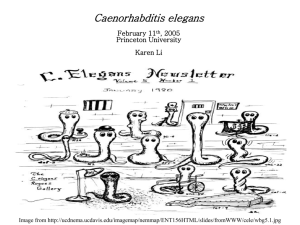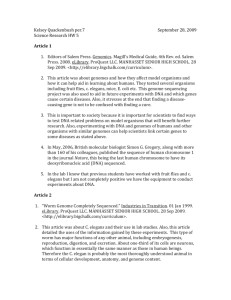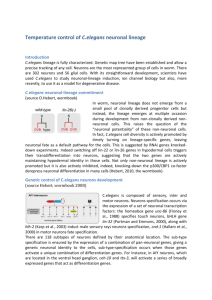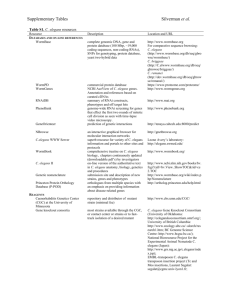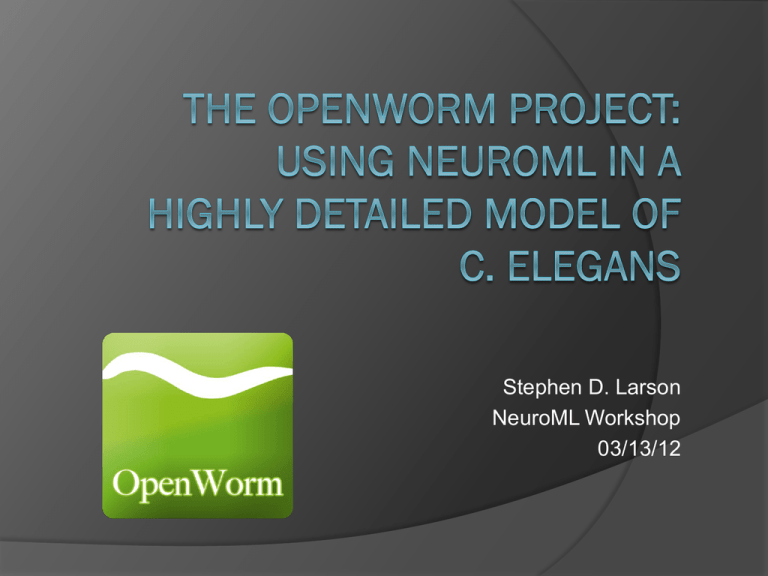
Stephen D. Larson
NeuroML Workshop
03/13/12
Enter the worm: c. elegans
I’ve only got
1000 cells in
my whole
body… please
simulate me!
In search of nature’s design principles via
simulation
•
How can a humble worm regulate itself?
– Reproduces
– Avoids predators
If –we
can’t
understand
Survives
in different
chemical andgenes to
temperature environments
behavior
here, why would we
– Seeks and finds food sources in an ever
expect
to understand
it anywhere?
changing
landscape
– Distributes nutrients across its own cells
– Manages waste and eliminates it
Virtual physical organisms in a
computer simulation
Closing the loop between a worm’s
brain, body and environment
Simulated
World
Detailed
simulation
of worm
body
Detailed
simulation
of cellular
activity
The goal: understanding a faithfully
simulated organism end to end
Extracting mathematical principles from smaller biological
systems is necessary if we are going to understand and
reconstruct the much larger system of the human.
Outreach: put the model online
and let the world play with it
•Sex:
Hermaphrodite
•Interested in:
Escaping my worm
Matrix
•Relationship
status: Its
complicated.
Worm biology
~1000 cells / 95 muscles
Neuroscience:
302 neurons
15k synapses
Shares cellular and molecular structures with higher
organisms
Membrane bound organelles;
DNA complexed into chromatin and organized into discreet
chromosomes
Cell control pathways
Genome size: 97 Megabases vs human: 3000
Megabases.
C. elegans homologues identified for 60-80% of
human genes (Kaletta & Hangartner, 2006)
Entire cell lineage mapped
Christian Grove,
Wormbase
Entire cell lineage mapped
Christian Grove,
Wormbase
Entire cell lineage mapped
Christian Grove,
Wormbase
Entire cell lineage mapped
Christian Grove,
Wormbase
Full connectome
Varshney, Chen, Paniaqua, Hall and Chklovskii, 2011
Biomechanics
P. Sauvage et al. / Journal of Biomechanics 2011
Interrogation of Behavior
Liefer et al., 2011
C. Elegans disease models
•Metabolic syndrome
•Diabetes and obesity
•Ageing
•Oncology
•Cancer
•Neurodegeneration
•Alzheimer’s disease
•Parkinson’s disease
•Huntington’s disease
•Neurobiology
•Depression
•Pain, neuronal
regeneration
•Genetic diseases
•ADPKD
•Muscular dystrophy
•Ionchannelopathies
•Innate immunity
Kaletta & Hengartner, 2006
Can present drugs
Kaletta & Hengartner, 2006
March– Sept 2011
Team – A brief history
Collaboration technologies used
Mechanical model
Palayanov, Khayrulin, Dibert (submitted)
3D body plan
Christian Grove, Wormbase
Core platform
Viz
Opt
OpenWorm
Val
Sim
One core hooks together multiple simulation
engines addressing diverse biological behavior
Core simulation
platform
Cellular
motility
Cellular
metabolism
Cell
membrane
excitability
Synaptic
transmission
Sensory
transduction
Estimates of computational
complexity
Mechanical
model
~5 Tflops
Muscle
/ Neuronal
conductance model
~240 Gflops
One Amazon
GPU
cluster provides 2
Tflops
Source: http://csgillespie.wordpress.com/2011/01/25/cpu-and-gpu-trends-over-time/
Simulation engine libraries
Simulation Engine
OSGi
JavaCL
OpenCL
NVIDIA Tesla drivers
Neuronal model
ms
Architecture proof of concept using Hodgkin-Huxley
neurons
GPU Performance Testing:
302 Hodgkin-Huxley neurons for 140 ms (dt = 0.01ms)
Worm Browser
http://www.youtube.com/watch?v=nAd9rMey-_0
Finite element modeling
Neuron models from Blender to NeuroML
Put the parts back together
•Spatial model of cells converted to NeuroML
•Sergey Khayrulin
• Connections defined
•Tim Busbice + Padraig Gleeson
• Ion channel placeholders
•Tim Busbice + Padraig Gleeson
• Inferred neurotransmitters
•Dimitar Shterionov
http://openworm.googlecode.com
Open Worm Team,
March 2012
Focus on a muscle cell
Case study: locomotion
Gao et al, 2011
Muscle cell with “arms”
Cell Body
Boyle &
Cohen,
2007
Cell body, 1
compartment, active
currents
5 arms,
10 compartments
each, passive
currents
Conductance model of c. elegans
muscle cell
Boyle & Cohen, 2007
Quadrants of muscle cells
Quadrant 2
Quadrant 1
Cell
Body
Cell
Body
Cell
Body
Cell
Body
Cell
Body
Cell
Body
Cell
Body
Cell
Body
Cell
Body
Cell
Body
Cell
Body
Cell
Body
Muscle cell roadmap
Physics: Smoothed Particle Hydrodynamics (SPH)
Progress with optimization
Alex Dibert
Progress with optimization
Alex Dibert
Progress with optimization
Alex Dibert
Progress with optimization
Alex Dibert
Current challenges
Better integration of genetic algorithms
into simulation pipeline
Filling in the gaps of the ion channels for
the spatial connectome
Multi-timescale integration of smoothed
particle hydrodynamics and
conductance based electrical activity of
muscle cell
Multi-scale synthesis in c. elegans
•
•
•
•
Motivated highly detailed
simulations in a small, well
studied organism
Described the effort of a
distributed “virtual team” of
scientists and engineers
Described early results in
building a framework and
engine for c. elegans
simulation
Described current
opportunities for contribution


